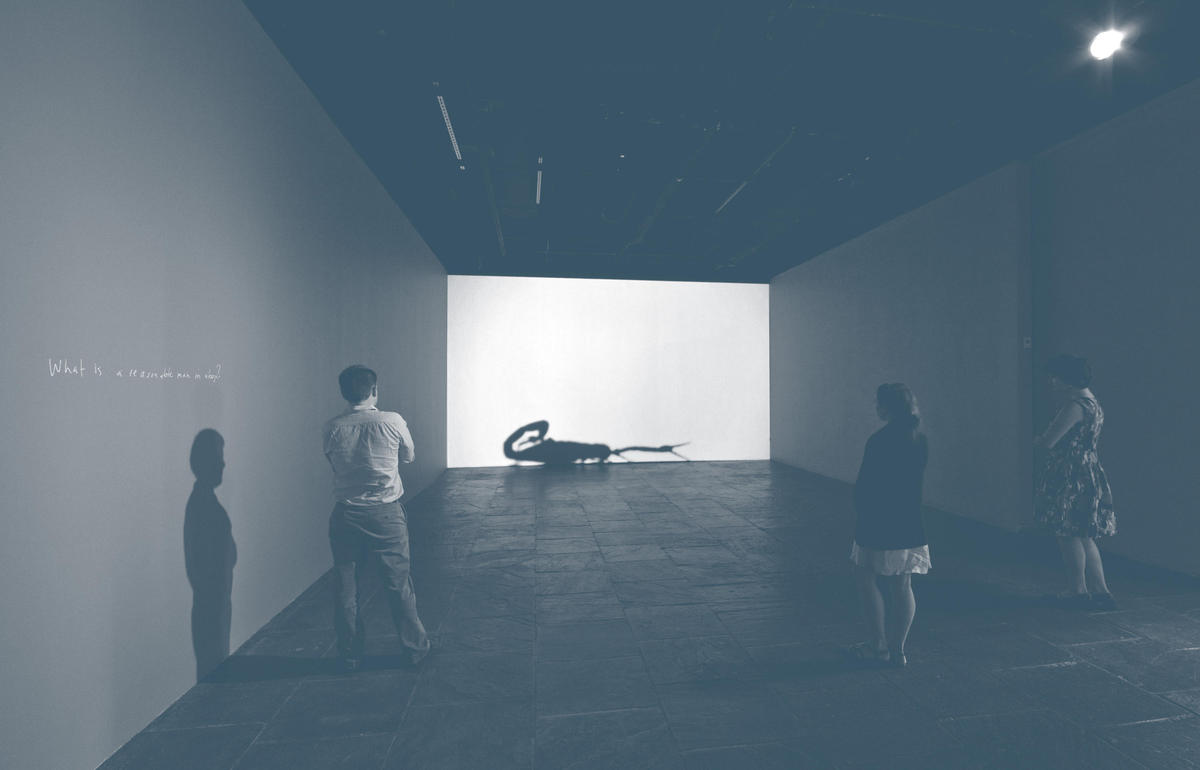
New York
Jill Magid: A Reasonable Man in a Box
Whitney Museum of American Art
July 1–September 12, 2010
New York
Natascha Sadr Haghighian: Fruits of One’s Labour
Ludlow 38
July 7–August 15, 2010
Jill Magid’s A Reasonable Man in a Box, her first solo showing at an American museum, broached questions related to legal conceptions of torture. Her setup was simple: a narrow doorway led to a dark gallery, where one wall was filled with the shadow of a huge scorpion crawling in and out of the frame. There were amplified sounds of scratching, scurrying, and tail snapping. Two spotlit wall-texts captioned the experience. The first comprised snippets of a legal document, which began: “You would like to place a man in a cramped confinement box with an insect.”
The line is drawn from a 2002 memorandum from the US Justice Department to the CIA, one of the now infamous “torture memos” that outlined legal loopholes for using torture on interrogation subjects. Magid’s work isolated one example: if the subject is not explicitly informed that the insect placed in the box with him is dangerous, then he’s not technically being tortured. “A reasonable person in his position,” the document declares, “would not reasonably feel threatened.” Magid’s response, phrased as a rhetorical question, was scrawled on the opposite wall: “But what is a reasonable man in a box?”
Very often, Magid exists as the central protagonist of her works, infiltrating systems of authority — the Dutch secret service, the New York Police Department — to coax out their inner contradictions. The recent work, however, seemed more bent on creating an intimate encounter between viewer and artwork, in order to give substance to the text’s absurd claims to reason. This is not to say she recreated the experience of torture, or even introduced a new topic into public debate. Rather, Magid used enlargement and amplification to produce a visceral encounter with an abstraction: the state’s wanton manipulation of language. The video elicits in the viewer the same disgust and perverse fascination that the dry, yet creepy legal language of the memo provokes in the reader.
A comparable body-mind encounter was proposed at a more modest venue. At Ludlow 38, Berlin-based artist Natascha Sadr Haghighian presented Fruits of One’s Labor, also an exhibition made up of a single installation, in this case accompanied by several satellite events. The tiny storefront was taken up by a square cube made up of bricks of shredded paper. Steps led up to an old-fashioned stove with aluminum piping that twisted, curled, and passed through a glass wall. The glass prevented viewers from going any further, but the stovepipe was visible as it ended in a cloud of plastic green apples suspended from the ceiling. The dim soundtrack of trashy Euro techno matched the vaguely garish lighting scheme.
The bricks, the press release informed us, were made of shredded banknotes, formerly equivalent to ninety million Euros in all; the stovepipe “runs like a flow chart,” indicating the erratic turns of the economy. At first glance (or first press release reading), Fruits of One’s Labor was almost classical in its heavy-handed use of symbolic equivalences: shredded banknotes equaled devalued money; apples equaled fruits of labor; and so on. When it was first shown in Frankfurt, home of the European Central Bank, its invocation of labor gone up in a smoke of forbidden fruits was a response to the city’s history as a financial center, and was described as a reference to the aftereffects of the unified European currency.
In New York, an economic center of different scale, the installation was the placeholder for events relating to the recent financial crisis. There was a guided tour of the Museum of American Finance by the museum’s curator, Leena Akhtar (highlights included the history of financial scandals); a talk on “Financial Reform and Proprietary Trading” by financial scholar Robert Wosnitzer (with forays into “the aesthetics of the Bloomberg screen”); and two presentations on the theme of “Cultural Economies” — one by curator Axel-John Wieder on Sadr-Haghighian’s work with the Botschaft group in the 1990s, and another by artist and writer Jackie McAllister, on Art Club 2000 (a New York–based artist collective active in the 1990s). If the artist herself was not present, the pedagogic bent of the program was definitely in line with the rigorous research and reflexive, layered structure that informs much of her work.
Fruits of One’s Labor was described as a “diagram,” perhaps in the sense of Marcel Duchamp’s The Large Glass, which its glass-partitioned composition certainly resembled — the end game of modern art set against the end games of the economy. As a transparent diagram, the work sketched out a representation of events while directing attention outward, beyond the claustrophobic double storefront of Ludlow 38. In this way, its austere symbolism was thematically appropriate; money is, after all, about the circulation of symbolic value. If the installation was sealed behind glass, the work as a whole was an open structure that accommodated its changeable meanings.
That said, both exhibitions brought up the question often asked of discursive art: What exactly does the art space bring to the political or socio-economic questions at hand? Is the first-hand experience of the work’s coordinates — whether perceptual effects, symbolic equivalences, or the distribution of knowledge — really necessary? Is the art world really the best position from which to ponder such unwieldy political questions? In Magid’s case, the museum space offered her the chance to translate shock into a perceptual experience. In Sadr-Haghighian’s case, the interrelationships of art and the economy were a central theme of the work. But in final view, the effectiveness of both works was tethered to the attention span and intellectual commitment of their audiences — which, considering the casual, breezy, even shallow ambitions of most summer shows, was certainly a risky, perhaps even unreasonable, proposition.